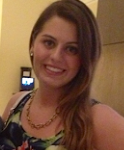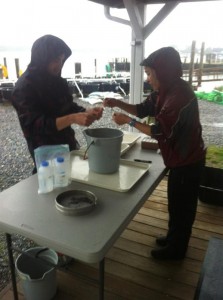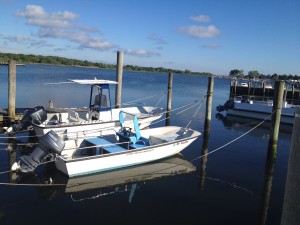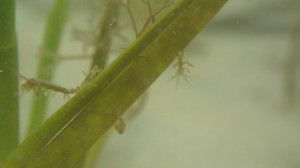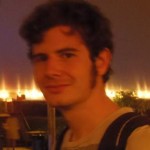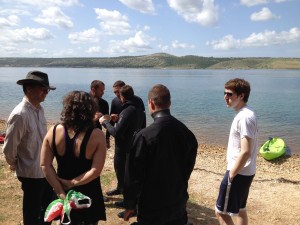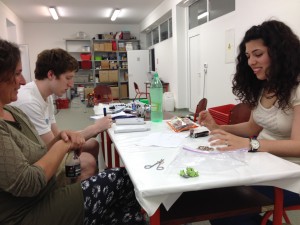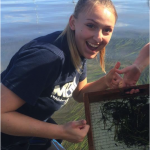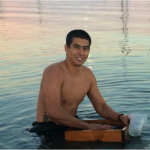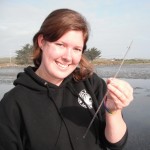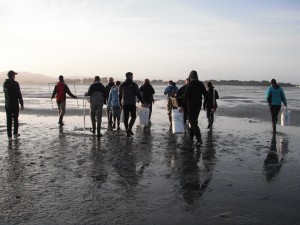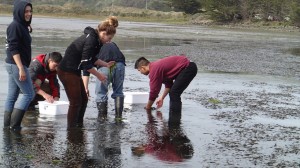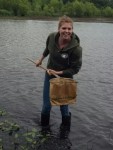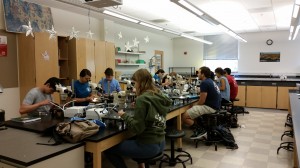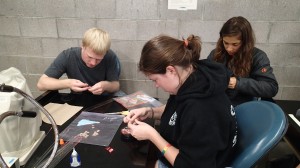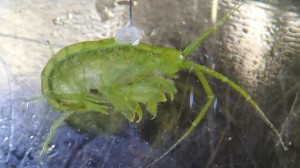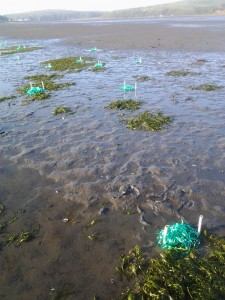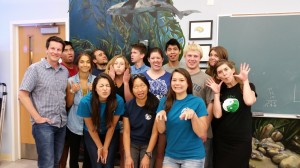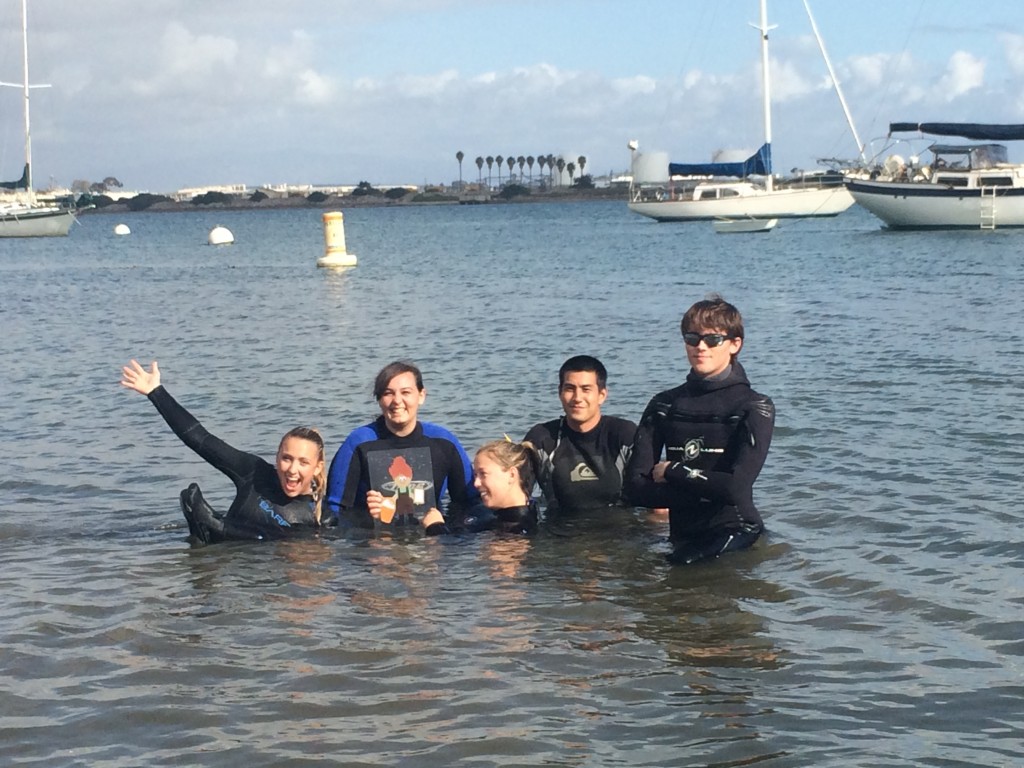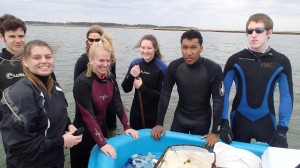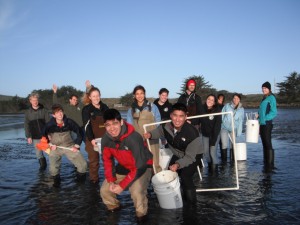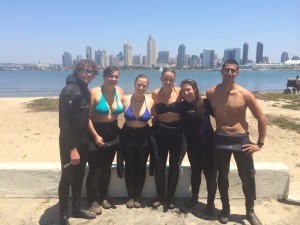A little closer to home – ZEN in Long Island Sound
by Ally Farnan (College of William and Mary undergraduate, ZENtern)
Even though Long Island is not a conventionally exotic location for a girl from New Jersey to spend the summer, it is starting out to be quite an adventure.
I arrived on site less than two weeks ago and I already feel like a part of the family here in the Peterson lab. I have spent the past week prepping for the ZEN experiments in the lab. Though a crucial step in the process of running experiments and conducting research, spending a week making aluminum packets, labeling, and weighing tins is not exactly thrilling. It is, however, a necessary part of the process, and is giving me some great practice for the eventual post-processing, sorting, and identification of field samples yet to come. I’m still figuring out where everything in the lab is located, but am getting some excellent help from the other undergraduate volunteers working the lab.
Luckily, I get to start running the actual experiments on Monday, which will also be the first time that I get to see the seagrass bed that we will be working in. Since I have been so busy in the lab, I haven’t had the opportunity to get into my wetsuit and see the site. The area that we are located in is beautiful, so I expect that the study site will also be wonderful!
I’m living a short drive from the lab with two graduate students, which gives me an interesting perspective on how different science research is from the typical 9-5 business job. My housemates, Rebecca and Sam, are excellent hosts and it’s so much fun to hear about the different kinds of research that they do. It should be really exciting to delve further into the experimental stages of ZEN so I can gain some hands-on experience myself.
The lab here is nearby, just off the water. The weather has been great most days, so I’ve been able to explore the area by jogging around town and by the beach. I hope to see some more of the sights around where I am staying. All of my new friends in the lab have given me some great ideas for how to spend my free time during the upcoming weekends - I can’t wait to discover what makes Long Island so special.
It is surprisingly chilly here, so I haven’t been brave enough to go swimming just yet since my toes freeze every time I stick them in the water. But, the sun is constantly shining, making for some beautiful drives around town with my windows down. I can’t wait to continue my adventures here by getting some fieldwork experience. I’ve already packed up my wetsuit so I don’t freeze in the cold water!
I’m so lucky to have a bunch of help in the lab, not only to settle me into a new space and help me to learn more about seagrass ecosystems, but also to advise me on some cold weather gear for our fieldwork in the next few weeks! I’m sure my future blog posts will be filled with some exciting fieldwork stories and hopefully I’ll still have a little free time to explore the area and tell you more about those experiences as well!
A close look at a seagrass creature – caprellids
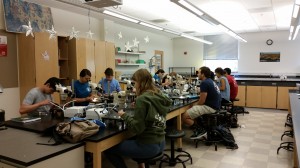
Students in the UC Davis ZEN class sort specimens of mesograzers – small invertebrates that live in seagrass beds
by Elena Huynh (undergraduate in the UC Davis ZEN class)
My first look under the dissecting microscope at a caprellid amphipod was alarming, to say the least. Enormous Claw-like mouthparts and red eyes stared straight back at me and I jumped back in my seat. Lucky for me, no one was there to observe my visceral reaction to this strange looking animal. After taking a moment, I knew that I would need to get comfortable looking at these odd creatures since we would be performing lots of species identifications during the course of the ZEN class at UCD, so I gave it another look under the scope. Despite the permanent menacing stare, this caprellid was not so scary, albeit a bit bizarre. I noticed a deadly looking spike behind its head and paused before learning that this protuberance is a defining characteristic of this caprellid species—Caprella californica!
After observing this caprellid’s scythe-like claws, I wondered what they were used for. As it turns out, caprellids are pretty clingy. They use their claws (gnathopods) and their legs (pereopods) to hang onto seagrass leaves and algae as they either graze the epiphytes that grow on top of the leaves or filter particles out of the water. Some caprellids can actually help seagrasses grow by cleaning the seagrass leaves and increasing their light exposure, increasing their growth. I guess caprellids would make good housekeepers, since they’re constantly cleaning off dirty surfaces.
Out in the field, I had the opportunity to watch caprellids swim. I wondered how these stick figures managed to get around. Through close observation, I noticed that they do a lot of crawling – which makes sense because they don’t appear to have pronounced flippers or large paddles. When they are not clinging to a surface or crawling they get around by moving like a wave. They curl up their bodies then push their feet and head back at the same time, over and over. It is pretty surprising to see what they manage to do with a body plan I’d consider adverse to swimming.
After doing a little research, I found out that some caprellids have hairs on their antennae – called swimming setae – that help them get around (Caine 1979). Although some can swim, they don’t swim very well nor do they swim for very long. If they’re living in beds of seagrass, all they would really need to be able to do is to hop to get from leaf to leaf. Learning more about what caprellids do for a living has helped me appreciate them, and they just might now be my favorite inhabitants of seagrass beds!
For more information, check out: Caine E.A. Functions of Swimming Setae within Caprellid Amphipods (Crustacea). 1979. Biological Bulletin 156:169-178.
“Bok” from Croatia!
by Austin Ruhf (College of William and Mary undergraduate, ZENtern)
Bok, or hello, from Croatia! I’m one of the ZENterns from the College of William and Mary and am spending my summer with classmate Dave Godschalk assisting with the ZEN research in beautiful Zadar, Croatia. I have only been at my host site for a week, but so far Croatia has been a welcoming and easy going paradise. Despite a comical amount of initial bureaucracy (it seemed like we needed the equivalent of a social security registration to gain internet access), the locals have been more than accommodating towards my ignorant American self. My host supervisor at the University of Zadar, Dr. Claudia Kruschel, has been fantastic to work with. She seems to never grow tired and goes out of her way to make sure that all of our work is a group effort. She even lent me her daughter’s guitar so I wouldn’t get musical withdrawal during my stay abroad!
The only downside is that the ZEN field sites are subtidal and are so deep that they have to be surveyed by professional divers. This means that the bulk of my and Dave’s work is done in the lab. The facilities are setup differently from the lab back at VIMS, but the work itself is similar. After a strenuous first week, we have settled into a manageable schedule.
Outside of the lab, fellow intern Dave and I have begun to explore Zadar in our spare time. Dave is already hooked on espresso and sparkling water, and I’m trying to discover more about the culture of the young people here. This led me to watch a heavy metal music show in an old puppet theater, which was pretty strange but somehow felt completely natural. We next hope to visit a few of the world-famous beaches here in Croatia, and learn how to best avoid the crowds of German tourists. Who knew that this was such a popular spot for science, and for a holiday?
A buoyant day in the field
by Whitney Dailey (San Diego State University undergraduate, ZENtern)
One of my favorite parts of the ZEN seagrass ecosystem ecology course at San Diego State University this past spring semester was working in the field and learning about seagrass ecology through a hands on approach.
One field day that I will never forget was when we were collecting our predation intensity experiment. The experiment consists of deploying several “tethers”, which are made by gluing grazers (in this case small grass shrimp or snails) to fishing line placed out in the seagrass bed. We then come back later to record whether the animals have been eaten. The purpose of the experiment is to understand the level of predation in the environment and the relatively susceptibility of different types of grazers.
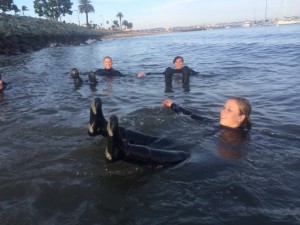
Whitney and classmates at SDSU learn the importance of being prepared for the unexpected – and in bringing weight belts out into the field
However, one of the main lessons that we learned during our time in the field with the ZEN class is that every experiment has its own challenges and the trick is to problem solve and find a way around it. On this particular field day we met the challenge of trying to schedule fieldwork around both our class schedule and the tide. For us this meant struggling to find the tethers in around 3 to 4 feet (1-1.5 meters) of water. While this may not sound challenging, we found it to be very difficult. We would try to dive down, but the extra buoyancy from our wetsuits at that shallow depth made us pop up to the surface right away. So, we just floated on the surface and would reach down and try to find them and pull them out. The trick was not giving up, and remembering to bring a weight belt in the future.
After many failed attempts of trying to retrieve the tethers, we were finally able to hold onto the pieces of rebar we’d installed to mark our experimental plots, and feel around until we found the tether and pulled it out. Every time we found a tether we would get so excited – until we moved on to retrieve the next one. But, with a lot of commitment and perseverance we completed our field day at our ZEN site in San Diego Bay and learned new methods for problem solving during fieldwork. We also learned that in marine ecology (and likely the other sciences) the truly exciting part comes from overcoming challenges, even the ones you didn’t anticipate!
Whitney graduated summa cum laude this May from San Diego State University, receiving her Bachelors of Science in Biology and Environmental Science. She has been working in seagrass ecology as part of Dr. Kevin Hovel’s lab for the past four years including on the initial ZEN projects in 2011-2012. Hailing from Washington, Whitney enjoys playing basketball and taking photographs in her spare time. This fall she plans to being a job as a research technician before applying to graduate school. Whitney will be traveling to work with Dr. Per-Olav Moksnes and his research group in Sweden as par of her ZENternship this summer.
Loving science for the challenge
by Christopher Bayne (San Diego State University undergraduate, ZENtern)
Field days have to be one of my favorite parts of science for two main reasons. The first reason is fairly obvious – we get to go out to the field site, which means getting some exercise, being in the sun, and working in the natural environment. You can’t beat that! The second reason is less intuitive. I really enjoy the challenges of fieldwork and problem solving. No matter how well protocols are planned and how many times you go over them, it seems that the smallest thing can turn into the biggest pain. Even though these problems can be time consuming and counterproductive, they keep you on your toes.
Along those lines, the ZEN predation intensity experiment comes to mind. The first time we deployed the experiment, which tested different materials as potential standardized prey to be used in experiments conducted by all of the ZEN partners, we used braided line threaded through different bait types. We separated each bait into separate bags for “quick and easy” deployment in the field. However, when we reached our field site we soon discovered that, when braided line goes into a bag, the mixture of moving around, getting wet, and Murphy’s law results in a knot so bad that you can barely distinguish one line from another. It just so happens that this occurred to six of our eight different bait types. What do we do?
We approached the problem like you do with so many other unexpected field issues. You accept it and just jump in headfirst. You approach the knot and honestly, there is no apparent advantage of coming at it at any certain way. You just begin trying to separate each line one at a time. You try different things: weaving the bait end through, loosening the most knotted sections, pulling the line through slowly. You swear you’ve undone hundreds of knots yet the ball of tangled string never looks as if any progress was made. Finally, you notice one looks as if it is almost loose. You put all your effort into that and get it out with this silent victory to yourself. Eventually they are all loose and you re-wrap them in a way that they will not get tangled up again. You think about what you could or should have done to avoid this mess. You finish up what needs to be done, knowing you are ready for whatever comes next.
In the end, the problem of the knotted line may be small but it is symbolic of the problems researchers face all the time. Little complications creep out of nowhere, completely unexpected. You try a million different solutions and begin to loose faith when nothing seems to work. If you have enough patience, the knot will eventually loosen and you will be victorious, swearing that you will never make that mistake again. This is why I have chosen to do science. It is challenging in so many ways. Learning the correct terminology, setting up experiments, finding solutions to unexpected problems – these are just some of the reasons why science is challenging and yet very rewarding.
Working on a project as large as ZEN adds an additional level of complexity in both coordinating large teams of people distributed all over the globe. This summer I will be travelling to Japan to work with the ZEN partners in both Akkeshi and Hiroshima. It is an amazing opportunity that not many undergraduates get to be a part of. I am looking forward to all of the challenges I will be facing this summer. I’m sure there will be more than a few but, if I’ve learned my lesson, tangled fishing lines will not be one of them!
Chris is a rising senior at San Diego State University pursuing his bachelor’s in biology and Japanese. Before starting the ZEN program Chris worked with Dr. Violet Compton Renick on her dissertation research examining the interactive effects of parasites and pesticides on killifish behavior. During the SDSU ZEN course Chris led a feeding experiment where he measured the grazing rates of several different types of San Diego mesograzer. This summer Chris will be traveling as part of his ZENternship to Japan to assist Drs. Massa Nakaoka and Massakazu Hori.
Science boot-camp at the Bodega Marine Lab
by Julie Blaze (UC Davis undergraduate, ZENtern)
Marine biologists don’t often find themselves trekking through dense remote jungles or climbing desolate mountains to conduct their research. Some would say we’ve got it pretty easy – the ocean covers around 70% of the earth’s surface, and studying biodiversity can be as easy as walking out to the coast and digging in the sand. The only downside to the job is that we are captives to the ebb and flow of the tides. My classmates and I in the ZEN class at UCD found that out the hard way when we took a field trip to the Bodega Marine Laboratory to survey the eelgrass growing in Bodega Harbor.
As someone who enjoys sleep, I can honestly say it is difficult to wake up at 5:30 am for any reason. Awake before the sun and trudging across the mud flats before its first rays had even reached the water, I know I wasn’t the only one thinking of the warm, comfy beds we had left behind. My boots were a little too big and kept getting stuck in the mud – I almost went sprawling face down into the mud more than once. As the sun rose, I wondered what we must have looked like to anyone watching from the shore – a zombie-like group of college students floundering in the mud. Slowly we gained more energy and set about surveying a large expanse of the seagrass bed collecting samples and taking measurements. We worked efficiently and conversation picked up as excitement and adrenaline grew with each new discovery and lapping reminder of the incoming tide. At first glance the mudflats and seagrass meadows look barren, but we quickly found that they teemed with life. Critters clung to the grass or buried themselves in the mud – making this eelgrass bed, similar to other seagrass meadows, one of the most diverse ecosystems in the ocean.
After a few hours the water had crept too high for us to work and we headed back to the lab to begin processing our samples. We put in a long day, getting as much done as we could before calling it quits. We all found those cozy beds soon after a late dinner, with the promise of another early field day tomorrow.
The next morning we again rose before the sun and stumbled out into the mud. But this time we were more familiar with the science – the methodology and how to work as a team – and we finished before the water chased us out.
By the end of the weekend I was thoroughly exhausted, but I didn’t care. We had spent an incredible weekend having an amazing adventure. Not only did I learn about the animals and ecosystem we were exploring, but I also learned several things about myself that weekend. First, I learned that I am willing and able to wake up before the sun to do research. Second, not even the wilds of a remote jungle can tempt me away from the mysteries of the ocean. And, finally, one lesson I will never forget – it’s easy to stay awake once your boots flood with freezing cold seawater. But, it’s even easier when you’re also out exploring a location as interesting as a Bodega Bay seagrass bed!
Julie is a graduating senior at UC Davis majoring in Biology. This summer she will be a ZENtern working with Dr. Nessa O’Connor in Ireland. Julie is a true team player and earned the nickname “den mother” during the 3-day, marathon class field trip and subsequent weeks of sample processing back on campus.
Photos contributed by Aaron Goodman.
A test worth taking
by Ellie Marin (UC Davis undergraduate, ZENtern)
Exams are inherently nerve-wracking. First there’s the main concern – did I study enough? Did I study the right material? And then there are other details – I have nightmares about running out of ink in my pen, accidentally missing questions on the back side of an exam
page, or even forgetting to write my name on the top of the exam paper. But, one thing I’d never feared was being stalled by accidently super gluing my hand to the exam paper itself. If there’s one thing I’ve learned from the Seagrass Ecosystem Ecology course taught by Drs. Pamela Reynolds and Jay Stachowicz that I’m taking at UC Davis, it’s to be prepared for the unexpected.
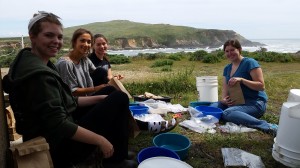
Ellie (left) and classmates conduct research at UC Davis’ Bodega Marine Laboratory for the ZEN undergraduate course in Seagrass Ecosystem Ecology
This hands-on field methods course was designed to educate the undergraduate students participating in the ZEN research (the “ZENterns”) on the methodology, theory, history, and purpose behind seagrass ecology and the Zostera Experimental Network. Our class featured a weekend trip to Bodega Bay, California to conduct field research, student presentations of papers from the primary literature, lectures, and group research activities. Today’s lab practical exam was intended to assess how much we learned from all of the different aspects of the course. In preparation for the exam, I read through my notes. It is a fairly hands-on class, so I wasn’t exactly sure how to study. Chatting with my 11 classmates revealed that we were all in the same boat.

UCD ZEN students perform the class practical exam, which involved answering questions on the course subject matter as well as demonstrating skills developed during the course.
Similar to other laboratory courses, our class practical featured a written portion as well as directed questions from a series of different stations setup around the laboratory. After a timed 30 minutes to complete the 5 pages of short answer questions, I started on the first lab station and the clock ticked down for us to rotate every 5 minutes. Some stations had microscopes with animals under them for us to identify and others materials for us to perform targeted lab skills. I glanced upon the familiar mesograzers under the scope, stumbled through some exotic amphipod identification, measured eelgrass shoots, and even wrote a haiku about epiphytes. The 5 minute periods per station rushed and rushed. I scribbled until the last second. And then I got to one station that fortunately, didn’t involve writing. Yes! Something I’ve done before! “Tether an isopod. Next, tether an amphipod.” We’d done this during our field trip at Bodega Bay to assess predation rates on mesograzers in the field. I got out the glue, set the line, caught the mesograzer. I was all set. No tricks. No doubts. I just had to tether the little guys. But this time it was different.
When we tethered the animals on the field trip, our instructors did not time us. This time I was racing against the clock. I quickly trimmed 20 cm of fishing line for the tether and began tying the proper knots to secure it. It wasn’t this difficult before! This line seems different! The sweat on my hands is not helping! After finally succeeding in tying an appropriate knot, I trimmed the line down and began looking for my first bug. I spotted one and bypass the forceps to plunge my hand into their housing container. I gently grab an isopod and place him on a paper towel to dry off. He’s sedentary. Good news. I grab the glue and squeeze a blob on the knot in my line. The next part is tricky. I have to glue his line – his crustacean leash – right onto his back. Success! After getting it to stick, I put the little guy into a water cup and watch him swim around with his little line in tow.
I’m half done now! I next set my sights on the amphipod. In the heat of the exam, I forget the order of the tethering process and plunge my hand into the container to grab the only amphipod I see. It’s a lively gammarid who undulates all over the paper towel, nearly off the table. This isn’t right! I put him back in the water. Focus! I grab the line and begin to cut to 20 cm again. The knot tying frenzy begins. Just go slow. I make a proper knot and grab the glue. It’s not coming out! I squeeze the glue harder than usual until a thick blob encases my knot… it’ll do. I grab my lively amphipod and he begins twisting and spinning – he’s expected me this time. I use a dropper to drip water on him as he lays on the paper towel. This appears to have a calming effect, and he ceases his tantrum. Now the tricky part. The isopod was big, but this guy is small, just under 1 cm in length. I have to get the glue right on the middle of his back or I risk injuring him. I go for it and miss, somehow getting glue all over my fingers. My fingers start to stick together. I unstick them and attempt to refocus in order to finish out this station – I know I’m almost out of time.
I rearrange my station for better focus, and this involves moving my exam out of the way. Big mistake. I have glued my hand to my exam. I rip the paper off, revealing a thumb and palm covered in ripped, sticky white paper. The timer goes off and I put my amphipod that wouldn’t get tethered back for the next student. “Next Station.” The test continues with new, equally challenging tasks and I proceed, with the paper still glued to my hand
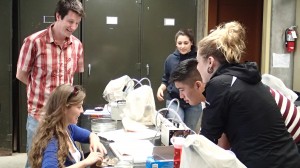
Drs. Pamela Reynolds and Jay Stachowicz (left) demonstrate amphipod tethering during the class field trip to the Bodega Marine Lab
The exam was hard. Not because I was underprepared – there are some things in life we can never prepare for. It was not unfair – I had either seen, performed, or learned everything on the exam. It’s not that there wasn’t enough time – everything in life has a time limit. The exam was hard because I have never had so much expected of me in a college class. Our instructors believe that we can do far more than simply answer A, B or C, or regurgitate a paragraph that we memorized from our notes. Our instructors dare us to reveal what we can actually contribute to science. They challenge us to be creative, resourceful, and clever. The point was to experience the exam, not just complete it. Success in research can be measured in how well we perform under stress. Things may not go as planned, but at the root of ecology is evolution, and we must all continue to adapt. This involves accepting our failures, building on our strengths, and focusing on how to move forward.
Some amphipods are meant to be free. Some tests are meant to be stressful. And some hands are meant to be glued.
Ellie is a rising senior at UC Davis pursuing her bachelor’s in biology. Her favorite aspect of the ZEN course was the exposure to field research, and her favorite experiment involved tethering amphipods to test for predation in the Bodega Bay seagrass beds. Her dream job is to be a science communicator and educator. She will be traveling to Ireland and Oregon to assist with ZEN research this summer with Drs. Nessa O’Connor and Fiona Tomas Nash, respectively.
Photos contributed by Aaron Goodman, Pamela Reynolds and Jay Stachowicz.
Surrounded by Science
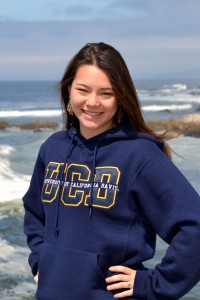 by Kendra Chan (UC Davis ZEN course undergraduate student)
by Kendra Chan (UC Davis ZEN course undergraduate student)
Over the past school year, I have finally found my people and my calling. I’ve been lucky enough to participate in the UC Davis ZEN course this spring quarter. Unlike your typical research university lecture hall of 300+ students, this class was limited to only 12 undergraduates. But it wasn’t the 6:1 student to faculty ratio that made this class special – rather, it was the people themselves.
As an underclassman, I was herded around the general biology pre-requisite path with the several hundred other students in the college. I found the intro biology series fascinating, but to my dismay, the majority of my peers expressed boredom even in the lab sections. However, this ZEN class was entirely different—it has been one of the few times I’ve been completely surrounded by people that are just as interested in marine ecology as I am, if not more (which I didn’t know was possible). Instead of being held back by classmates that lacked knowledge and interest about the subject at hand (e.g., marine communities), I was motivated and inspired by the passion and expertise demonstrated by the eleven other students and two instructors. Because of this, we were able to progress quickly through lecture topics and have intellectually stimulating discussions.
During the first class period, I knew I had found the right class because we had a lengthy and heated debate about how exactly to deploy the ASUs (Artificial Seagrass Units, or glorified green plastic ribbon) we had just built in order to get the most interesting data. This time, we the students were in control or our own experiment, and we had a plethora of scientifically interesting questions to ask. We weighed the pros and cons of each scenario, and after much discussion settled upon an experimental design.
Needless to say, the past 10 weeks have been a great learning experience for me. Not only did I become well versed in eelgrass ecosystems, but I also learned more about how to be a scientist through lectures, discussion, and my favorite, hands-on field work.
Although I won’t be exclusively working for ZEN this summer, I will still be immersed in eelgrass research. I’m excited to once again be surrounded by marine ecologists in Bodega Bay, and know I will continue to be inspired by both the scientists and the sea.
Kendra Chan is a rising senior at UC Davis. Her favorite experiment in the ZEN class was an assay of predation intensity in Bodega harbor. Her dream is to save the world with science – combining science and education with conservation and sustainability to better understand and utilize natural ecosystems.
Photos contributed by Kendra and Matt Whalen.
Meet the ZENterns
We are excited to be sponsoring 19 undergraduate students (hailing from the College of William and Mary, University of California, Davis and San Diego State University) to engage in hands on research with the ZEN program this summer. These “ZENterns” recently completed the ZEN Seagrass Ecosystem Ecology course at their home institution and will travel to different ZEN partner sites to assist with the 2014 field and laboratory experiments. They will be sending back blog posts periodically to report on their adventures – both domestic and abroad.
College of William and Mary
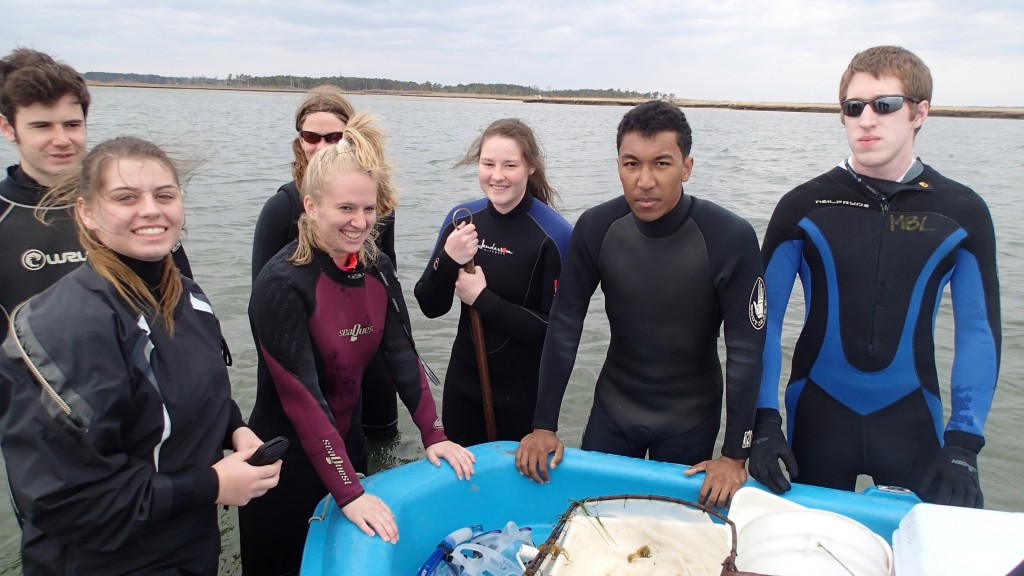
W&M ZENterns (left to right): Austin, Ally, Charlie, Danielle, Jessie, Kyle, and Dave (not pictured: Kara)
Kyle Belfort, double major in Biology and Environmental Science and Policy (2015). Kyle is from Virginia and is interested in restoration ecology. Outside of science he is competitive in both mock trial and volleyball. This summer Kyle will be working at the ZEN site in San Francisco, California.
Charles (Charlie) Deaton, Geology and Environmental Science double major (2015). From Virginia, Charlie is completing an honors thesis on barrier islands geology. He pays the sousaphone in the W&M Pep Band. Charlie will be working on ZEN projects in both Virginia and North Carolina this summer.
Allison (Ally) Farnan, Environmental Policy and Economics major (2016) . Ally grew up in Tokyo and Maryland and loves to sail, ski, and travel. This summer Ally will be assisting ZEN partners in both Connecticut and Quebec.
Kara Gadeken, Biology major (May 2014). Hailing from Northern Virginia, Kara is a competitive synchronized swimmer. Kara will be assisting with ZEN research in both Vancouver, British Columbia and back in Virginia.
David (Dave) Godschalk, Geology and Marine Science major (May 2014). Dave is originally from Virginia and completed an honors thesis in geology. He’s an avid rock climber and marathon runner. Dave will be traveling with Austin to assist ZEN partners in Croatia this summer.
Danielle Hall, Biology major (2015). Danielle is originally from Massachusetts and has been working with Dr. Duffy studying eusociality in Caribbean shrimp. She loves to dance – both inside and outside the seagrass beds! Danielle will spend the summer with ZEN partners in Vancouver, British Columbia as well as in Massachusetts.
Austin Ruhf, Biology major (May 2014). Originally from Virginia, prior to this summer Austin has only traveled outside of the USA once. When he’s not in the field he loves to play Beatles music and runs a coffeehouse. This summer Austin will be traveling with Dave to assist ZEN partners in Croatia.
Jessie Viss, Biology major (2016). Jessie is originally from California. She will be spending the summer with ZEN partners in Portugal.
University of California, Davis

The UC Davis ZEN class including ZENterns Julie, Josh, Natalia, Ellie, and Austin (not pictured: Nina).
Julie Blaze, Biology major (2014). Julie will be traveling with Ellie to assist ZEN partners in Ireland and then returning to assist with projects in Bodega Bay, California, and up in Oregon.
Joshua (Josh) Chow, Biology major (2014). This summer Josh is traveling to assist ZEN partners in Wales.
Elizabeth (Ellie) Marin, Biology major (2015). Ellie will be traveling with Julie to assist ZEN partners in Ireland and then returning to assist with projects in Bodega Bay, California, and up in Oregon.
Austin Greene, Biology major (2014). Austin is a budding photographer and research SCUBA diver. This summer Austin will be assisting ZEN partners in South Korea.
Nina Nichols, Biology major (2014). Nina speaks fluent French, loves baguettes and silent movies. This summer Nina will be working with ZEN partners in both Quebec and France.
Natalia Villegas, Biology major (2014). This summer Natalia will be working with ZEN partners in both Mexico and France.
San Diego State University
Christopher (Chris) Bayne, Biology and Japanese double major (2015). Chris hails from San Diego, California and loves everything water related – kayaking, surfing, swimming, you name it! He is also an AAUS trained research SCUBA diver. This summer Chris is traveling with classmate Josh to the ZEN sites in Japan.
Whitney Dailey, Environmental Science major (2014). Whitney grew up in Washington state. She plays almost every kind of sport and loves photography. Whitney is an AAUS trained research diver, NAUI Master diver, and PADI drysuit certified diver. This summer Whitney is traveling to the ZEN site in Sweden.
Joshua (Josh) Jaeger, Marine Biology major (2015). Josh is from San Diego, California and one of his favorite classes at SDSU was a philosophy course on knowledge and reality. Josh is also an AAUS trained research SCUBA diver. This summer Josh is traveling with classmate Chris to the ZEN sites in Japan.
Jennifer (Jen) Joseph, Marine Biology major (2015). Jen is from Northern California and is a research SCUBA diver. Jen loves everything Harry Potter and is a huge fan of the San Jose Sharks ice hokey team. Jen is traveling to the ZEN sites in Mexico and Massachusetts this summer.
Shay Hengen, Marine Biology major (2016). Shay grew up in Northern Idaho and has been working in Dr. Hovel’s lab since her freshman year at SDSU. Her hobbies include drawing, snowmobiling, and everything related to Batman. She will be traveling to assist with ZEN research in Finland this summer.
The ZEN of Active Learning
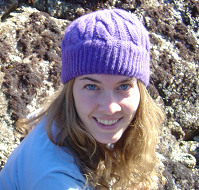 by Pamela Reynolds (ZEN postdoc and coordinator)
by Pamela Reynolds (ZEN postdoc and coordinator)
A novel component of ZEN2, in spring 2014 we launched a coordinated upper division undergraduate Seagrass Ecosystem Ecology course at each of the three core ZEN sites. Dr. Emmett Duffy and graduate student Jon Lefcheck instructed a group of 8 students at the College of William and Mary, Dr. Kevin Hovel and graduate student Erin Voigt taught 6 students at San Diego State University, and Drs. Jay Stachowicz and Pamela Reynolds co-taught another 12 students at the University of California, Davis. The course focused on ecological theory and hands on training in marine ecology field methods. We incorporated lectures and readings of the primary literature with field trips and student-led surveys and experiments.
Each course topic and experiment in the course corresponded to a main theme and goal of ZEN – from top-down/bottom-up ecology and biodiversity ecosystem functioning to experimental design and habitat restoration. In an immersion instruction style, students performed research typical in marine ecology, working both indoors and outdoors, with living organisms, under a wide variety of conditions. The students gave presentations both within their own class and, via teleconferencing, to the other ZEN classes. The course gave students a rigorous background in not only the “why” behind the science and a sense of the history of the field, but also the “how” of doing the science itself. With such small class sizes we were fortunate to be able to engage the students in this active learning style and to really connect with and get to know them. Success in the class was assessed by the students’ ability not to simply memorize facts, but to apply the core concepts of the course to design novel approaches and problem solve both individually and as a team. We hope that additional ZEN partners will engage with similar networked courses in the future and further strengthen the connections among our diverse partnership.
A subset of the students in the ZEN classes are participating in our ‘ZENternship’ program -a hands on training experience following the prior ZEN graduate student exchange program of 2012 and modeled after the NSF Research Experience for Undergraduates program. The ZENternship for 2014 involves student travel to different partner sites this summer to assist with ongoing ZEN research.
We were thrilled to have a great group of students participate in this first ZEN class and can’t wait to hear about their summer research experiences – both at home and abroad. And, we are all more than a little bit jealous that we didn’t have such an integrative class to take when we were undergraduates!
Check back here to read more about the ZENterns and their experiences conducting research at home and abroad this summer.

